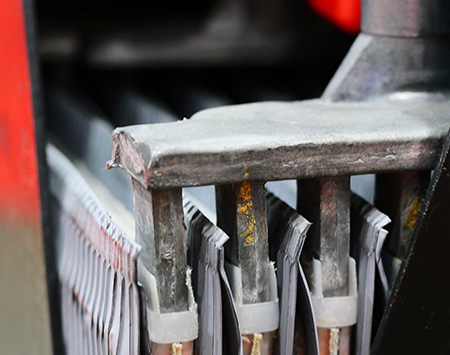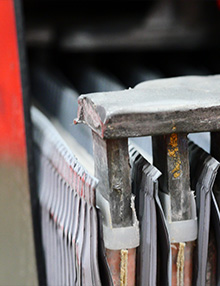Whether you're shopping for a new car or truck battery or simply curious about how your vehicle works, understanding a car battery structure can be helpful for every motorist. In this guide, we'll explore the basic structure of a car battery, how it works and the essentials of cold cranking amps.
Car Battery Structure
A standard car battery is made up of three basic components:
- The casing: This is the covering that protects the inner workings of your battery. It's usually made of sturdy plastic and is acid-resistant to keep from interfering with the battery or degrading over time.
- The electrolyte solution: This is usually a 37-percent sulfuric acid solution that acts as a chemical catalyst.
- The plates: These are lead plates and lead dioxide plates that are arranged in alternating layers. They sit inside the electrolyte solution to create a chemical reaction.
In a working battery with no cracks or breaks, the only parts of the battery that are visible are the casing and the terminals. The terminals are two raised pieces at each end of the battery that transmits energy from the battery into your car. The positive terminal is red, and the negative terminal is black.
How it Works
Once you're familiar with the structure of a car battery, you’re ready to explore how it works. The lead plates sit in a bath of sulfuric acid, which acts as a catalyst for the chemical reaction required to generate energy.
- The acid reacts with the lead dioxide plate (the positive electrode), which creates ions and lead sulfate.
- The ions then react with the lead plate beside them (the negative electrode), which makes hydrogen and lead sulfate.
- This creates a chemical reaction that makes electrons and this electricity flows out of the battery terminals to power your car.
This chemical reaction is reversible, which is why you can use a car and truck charger to power up your battery if you discover it's running low.
What is CCA?
If you're shopping for a new car battery, you might notice that different batteries offer different CCA ratings. But what does CCA mean on a battery? CCAs, or cold cranking amps, describe how well a battery can start a car under cold conditions. Standard CCA refers to classic 12-volt car batteries – the higher the CCA, the better the battery is at starting in the cold.
How Many CCAs Do You Need?
Car and truck batteries are primarily used for starting up your engine and powering your lights and vehicle accessories. Once the engine starts, the alternator supplies power to your car, so the main job of your battery is to give you a short and strong burst of energy.
So, if your battery is used as a starting power, you might be wondering how many CCAs you really need? The main considerations will be the climate you live in and the model of your car. Typically, warmer climates require lower CCAs, since it's easier to start up a car battery in warm temperatures. If you live somewhere with very cold winters, it might be worth shopping for a higher CCA.
Your vehicle manufacturer can also help you find how many CCAs are best for your car. The amount of start-up power you need also depends on your engine size, circuit resistance, and accessories, so consult your vehicle handbook or drop by your local Batteries Plus location for help finding the best car battery for your needs.
Once you've found the perfect battery, it's time to install it and get your car running smoothly. Explore our helpful guide on how to change a car battery yourself, or have one of the experts at your local Batteries Plus help you out.

